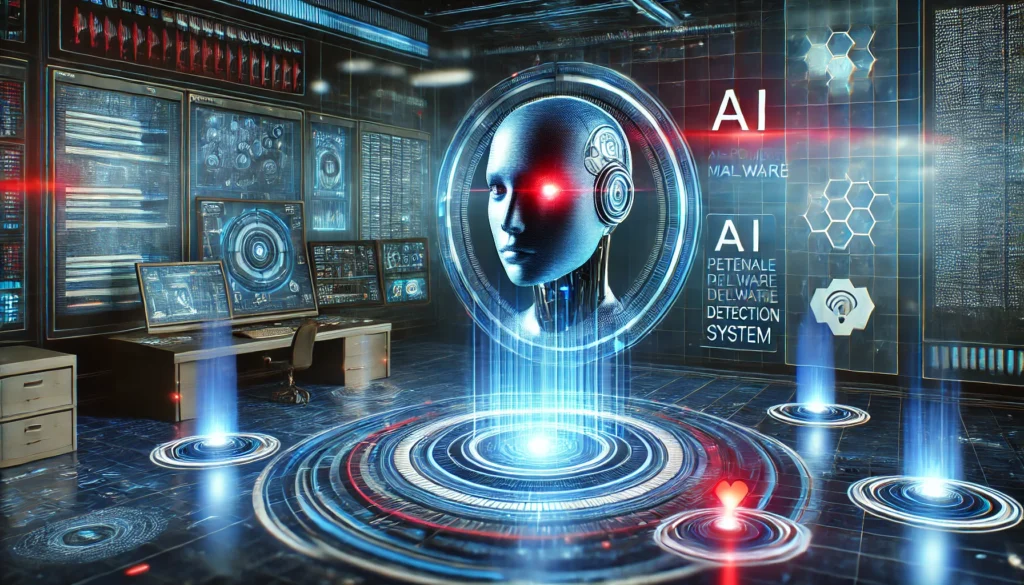Cyber threats are evolving at an alarming rate, making traditional malware detection methods less effective against modern, sophisticated attacks. With the rapid advancements in artificial intelligence (AI), cybersecurity experts are leveraging AI-powered malware detection to enhance security measures, identify emerging threats, and protect users from cyberattacks in real time.
This article explores how AI is revolutionizing malware detection, covering its benefits, key technologies, real-world applications, and the challenges it faces in combating cyber threats.
How AI-Powered Malware Detection Works
AI-powered malware detection goes beyond traditional signature-based methods, using machine learning and deep learning algorithms to detect patterns and anomalies in real time. These systems analyze vast amounts of data, detect suspicious activities, and predict cyber threats before they cause harm.
1. Machine Learning-Based Threat Detection
- AI algorithms are trained on large datasets containing both malicious and legitimate software.
- By recognizing behavioral patterns, AI can flag suspicious activities, even if they don’t match known threats.
- Unlike traditional antivirus software, machine learning models evolve as they encounter new malware strains.
2. Behavioral Analysis of Files and Programs
- AI-powered security systems analyze the behavior of files instead of relying on predefined virus signatures.
- This technique is particularly effective against zero-day attacks, where no existing signature is available.
- If a file starts executing actions similar to known malware (e.g., modifying registry keys, encrypting files), AI can block or quarantine it before damage occurs.
3. AI in Email Security
- Phishing and ransomware attacks often begin with malicious emails.
- AI-driven email security solutions scan email patterns, detect spoofing attempts, and flag phishing emails with high accuracy.
- These systems use natural language processing (NLP) to identify misleading language and scam attempts before users fall victim.
Key Benefits of AI in Malware Detection
1. Faster and More Accurate Threat Detection
- AI detects threats in real time, reducing response time from hours or days to seconds.
- It minimizes false positives, improving overall security efficiency.
2. Adaptability to New Threats
- Traditional antivirus software relies on signature-based detection, which requires constant updates.
- AI can identify and block malware variants without needing an updated virus database.
3. Automated Incident Response
- AI-powered security tools can automatically isolate infected systems, preventing malware spread.
- Automated alerts and threat reports help security teams act quickly.
Real-World Applications of AI-Powered Malware Detection
1. DIANNA by Deep Instinct
- An AI-based malware analysis tool that provides real-time detection for known and unknown threats.
- It uses deep learning to predict and prevent attacks before execution.
2. Google’s AI-Driven Security Measures
- Google applies AI to detect and block malware in Gmail, Play Store, and Chrome.
- AI models analyze billions of files and apps daily, identifying potential threats at scale.
3. Palo Alto Networks’ AI Security
- Uses AI-driven firewalls and endpoint protection to defend against cyber threats.
- Its advanced analytics platform detects malware across cloud networks and enterprise environments.
Challenges and Risks in AI-Powered Malware Detection
Despite its effectiveness, AI-based security systems are not foolproof. Cybercriminals are increasingly using AI to develop advanced malware that can evade detection.
1. AI-Generated Malware
- Hackers use AI to create polymorphic malware, which changes its code structure to bypass traditional detection.
- AI-powered cyberattacks are designed to learn and adapt, making them harder to track.
2. Adversarial Attacks on AI Systems
- Attackers manipulate AI models by introducing malicious data to confuse detection algorithms.
- This can cause AI security tools to misclassify malware as safe, allowing threats to slip through.
3. High Computational Requirements
- AI-powered cybersecurity tools require significant processing power, which may not be feasible for smaller businesses.
- Cloud-based AI security solutions help mitigate this issue but introduce data privacy concerns.
The Future of AI in Cybersecurity
As cyber threats become more sophisticated, AI will continue to play a crucial role in automated threat detection and response. Future developments include:
- Self-learning AI models that autonomously improve their detection capabilities.
- AI-powered threat intelligence platforms that predict and neutralize attacks before they happen.
- Enhanced AI-human collaboration, where AI handles routine security tasks while experts focus on strategic threat analysis.
Conclusion
AI-powered malware detection is a game-changer in cybersecurity, offering faster, more accurate, and adaptive protection against cyber threats. While challenges remain, continuous advancements in AI and machine learning will ensure that cybersecurity defenses stay ahead of evolving threats.
By integrating AI-driven security solutions, businesses and individuals can significantly reduce their vulnerability to cyberattacks, making the digital world a safer place.


